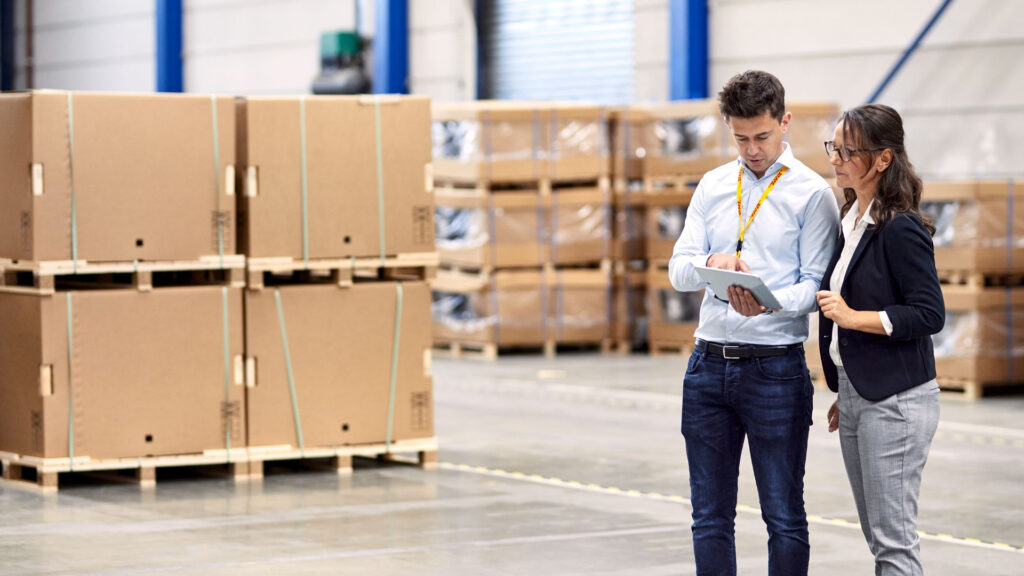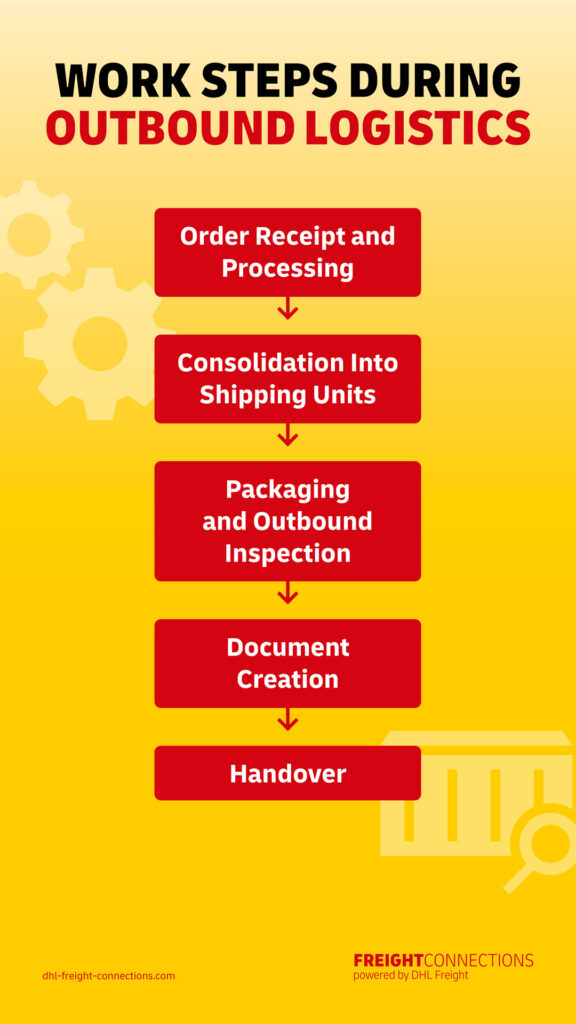
For production and trading companies, outbound logistics are the final step within the internal value chain. In outbound logistics, all measures are taken to ensure that the goods leave the company properly—and there is a final opportunity to check their quality. Read here which activities are crucial for outbound logistics and how they can be optimized.
Outbound Logistics: Definition
Similar to its counterpart, inbound logistics, outbound logistics serves as a junction between warehouse and transportation management. Outbound logistics involves the provision of items from a warehouse. It also encompasses the final internal company checks, preparations for transporting goods, and the creation of necessary accompanying documents.
For manufacturing companies and retailers or intermediaries, outbound logistics marks the end of the internal supply chain.

Outbound Logistics: Tasks
In outbound logistics, the focus is on avoiding incorrect deliveries to customers in terms of quantity and quality, ensuring that the goods withstand transportation without damage, and complying with legal or accounting requirements through accurate documentation. Customer satisfaction hinges on outbound logistics. The tasks of outbound logistics include:
- Consolidation: When goods needed for a shared shipment are stored in various sections of the warehouse, outbound logistics personnel ensure the accurate assembly of the shipment.
- Inspection: Before goods leave the warehouse eventually, they are rechecked. Outbound logistics serves as the final checkpoint in the warehouse.
- Provision: Self-produced items or stored goods are made available for either self-collection or are handed over to a transportation service provider; possibly even the company's internal transportation. Smaller items are prepared for postal shipping.
- Transport Preparation: Through careful packaging and instructions for appropriate handling during transportation, outbound logistics staff contribute to securing the cargo.
- Creation of Accompanying Documents: Additionally, staff document the necessary information on delivery notes and invoices.
Outbound Logistics: Process and Procedures
Maintaining high quality in the outbound logistics process requires well-coordinated workflows. The individual steps in outbound logistics are as follows:
Order Receipt and Processing
The company receives an order for specific items or multiple products. Once the availability of the requested goods is confirmed through electronic inventory management, the order is forwarded to the warehouse logistics team or the responsible personnel at a logistics center.
Consolidation Into Shipping Units
All individual components of a shipment are retrieved from the warehouse and placed in staging areas in the outbound logistics section. Outbound logistics ensures that individual items are grouped into reasonable and efficient shipments, such as all items for a single customer or multiple shipments to a single destination region. Once shipping units are created, they are packed into individual or collective cartons.
Packaging and Outbound Inspection
Goods are inspected before and during packaging. Defective items must be replaced, and the completeness of the articles must be ensured before sealing the packages. Proper packaging must also be rechecked to prevent disruptions in the supply chain due to transport damage after leaving the warehouse. The outbound inspection and the flawless condition of the goods are documented to safeguard the company in case of damage occurring after the goods leave the warehouse.
Document Creation
Once the items are inspected and packaged, the necessary shipping documents, such as delivery notes, invoices, packing lists, or bills of lading, are generated. Depending on the destination, customs documents might also be required. For smooth delivery, address labels and labels with the unit's shipping number (SUN) are necessary.
To enable customer-friendly shipment tracking, shipping data is transmitted to the executing transportation logistics provider. During the electronic recording of outbound logistics and document creation, inventory changes are reported to the internal system, allowing for necessary reorders or reproduction.
Handover
If the goods are not self-delivered, they are handed over to the recipient (for self-collection) or a transportation service provider along with the documents. Instructions regarding the sensitivity of the cargo and securing the load contribute to transportation safety and customer satisfaction.

Outbound Logistics KPIs
Efficiency and quality can be assessed by using Key Performance Indicators (KPIs) for outbound logistics. Some crucial metrics include:
- number of delivered and dispatched goods
- capacity utilization of storage and staging areas
- personnel capacity utilization
- lead time for ordered inventory
- error rate in inspections
- number of documents requiring correction
Warehouse metrics reveal areas where outbound logistics can be optimized: Is there sufficient staff and space? Does a high error rate indicate a need for employee training? Where can excess capacities be reduced?

Optimizing Outbound Logistics
To optimize outbound logistics processes and contribute to the overall performance of a company or logistics center, KPIs should be regularly evaluated, and workflows adjusted as needed. Depending on the level of automation in a warehouse, tasks such as consolidation, inspection, and packaging can be labor-intensive. Especially processes involving document creation should be automated. Moreover, all employees should have real-time access to relevant information. Information exchange speeds up processes, reducing customer wait times for orders. Advanced IT management systems for warehouses keep internal staff informed and provide external logistics partners with access to information.
Connecting employees, partners, and information reduces error rates, increases transparency and predictability of workflows, and improves capacity utilization. Altogether, this enhances outbound logistics efficiency.
Outbound logistics ensures that ordered products leave the warehouse promptly and reach the customer. It also offers producers and retailers the final opportunity to conduct quality checks on their goods. Both aspects make outbound logistics a crucial factor for customer satisfaction and retention. Modern IT solutions and networking increase outbound logistics efficiency. In the realm of logistics, outbound logistics serves as a nexus between intralogistic and transport logistic processes.
As an experienced service provider in transport logistics, DHL Freight contributes to the efficient design of outbound logistics through competence and collaboration.
Frequently Asked Questions
- What does outbound logistics mean? Outbound logistics refers to the provision of items from a warehouse. The task of outbound logistics also involves checking the items, preparing them for transport, and documenting the process.
- Which processes are part of outbound logistics? Outbound logistics includes: consolidating goods into reasonable and efficient shipments, packaging them, conducting quantitative and qualitative outbound inspections, creating accompanying documents such as invoices, delivery notes, or SUN labels, and finally handing them over to the recipient or a transportation service provider.
- What are KPIs in outbound logistics? Some outbound logistics KPIs are: the number of delivered goods, utilization of area and personnel capacity, lead times for ordered products, inspection error rates, and the number of documents requiring correction.
- How can outbound logistics be optimized? Processes in outbound logistics can be optimized through automation and networking of all process participants through advanced IT systems. This reduces error rates and enhances transparency, predictability, and capacity utilization.



